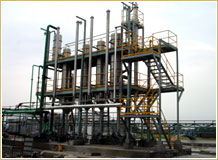Sewage Treatment Plant
Sewage Treatment Plant is the process of removing pollutants from wastewater and household sewage, both effluents and domestic. It includes Physical, Chemical & Biological treatment to remove contaminants.
- Moving Bed Bio Reactor (MBR)
- Activated Sludge Process (ASP)
- Membrane Bio Reactor (MBR)
- Sequential Batch Reactor (SBR)
- Electrooxidation (EO)
- Fluidized Aerobic Bed Reactor (FAB)
- Submerged Aerobic Fixed Film Reactor (SAFFR)
Prefabricated and Containerized STP plant is also available.
Effluent Treatment Plant
ETP (Effluent Treatment Plant) is a process design for treating the industrial waste water for its reuse or safe disposal to the environment.
ETP plant involves wastewater treatment process for treating contaminants in the form of organic matter, inorganic matter, heavy metals, oil & grease, suspended solids etc. The treatment methodology can be either batch process or continuous flow process.
We offer Effluent Treatment Plant in different set ups like Civil, Prefabricated and Containerized etc.
Our Effluent Treatment Plants are designed to achieve superior Treated Wastewater Standards.

Zero Liquid Discharge System
Zero Liquid Discharge (ZLD) is a process to remove all the liquid waste from
a system. It eliminates waste and maximizes water usage efficiency.
In recent years, greater recognition of the dual challenges of water scarcity and pollution of aquatic environments has revived global interest in ZLD. More stringent regulations, rising expenses for wastewater disposal, and increasing value of freshwater are driving ZLD to become a beneficial or even a necessary option for wastewater management.

Ultrafiltration Plant
Ultrafiltration (UF) is a variety of membrane filtration in which forces like pressure or concentration gradients lead to a separation through a semipermeable membrane. Suspended solids and solutes of high molecular weight are retained in the so-called retentate, while water and low molecular weight solutes pass through the membrane in the permeate.
Reverse Osmosis Plant
Reverse Osmosis (RO) is a widely accepted treatment for water purification. It mainly removes TDS from the wastewater. High pressure water is passed through membranes, producing high quality water suitable for reuse and recycle.

Water Softening Plant
Water softening is the removal of Calcium, Magnesium and certain other metal cations in hard water.
Water softening is usually achieved using Lime Softening or Ion-Exchange Resins.

Demineralization Plant
A DM Water System produces mineral free Water by operating on the principles of ion exchange.
ETP, STP & WTP Trouble Shooting, Operation & Maintenance
EPL offers Annual Maintenance Contract with team of expertise at site and also at back office to ensure smooth operation of water and wastewater treatment plants.
